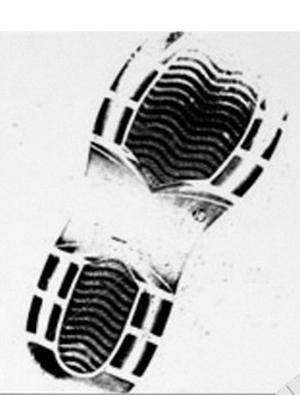Top 10 crime-fighting technologies, I
Today’s criminals avail themselves of the latest technological innovations in order to stay one step ahead of the law; fortunately, technological advances help law enforcement balance the criminals’ arsenals and keep societies safer than otherwise would be the case

Under U.K. law, the shoeprint has the same legal validity as a fingerprint // Source: zazzle.com
Hi-tech GPS-enabled phones, more accurate guns, and faster cars — the criminals of today are equipped with the latest technology money can buy. Fortunately, technological innovations are helping law enforcement keep pace with the criminals.
Mankani Deepa offers this quick look at ten intriguing technologies used by law enforcement units in advanced countries to fight crime. In the coming weeks we will discuss each of these technologies in greater detail. We adopt the David Letterman’s Top 10 method, going from No. 10 to No. 1.
10. Automated license plate recognition cameras. Car thieves should now be aware that stealing a car is not enough. Once they take it on the road, the car may be spotted they may be recognized , automated license plate recognition cameras are being used by patrol cars (even choppers) to track down auto-related crimes. These cameras can take pictures of the license plates from a distance. The pictures are run against a database of stolen vehicles to find possible matches (see “HTS Unveils Vehicle Identity Recognition System,” 24 February 2010 HSNW).
9. Brain fingerprinting. Cops are advised to get into the mind of the criminals to handle them better. Well, now they can take the advice literally. In brain fingerprinting, the subject is shown pictures on a computer screen. This person has to wear a headband that will measure cognitive brain responses to the stimuli he watches on the screen. An EEG (electroencephalograph) picks up distinct responses to words, sounds or images that are related to the crime.
The technology has been used to obtain guilty plea from criminals who had refuted allegations of knowledge about their crimes. Brain fingerprinting revealed that their brains responded to crime-related details shown on the computer.
8. Shoe printing. This may well be one of the technologies which is going to make “perfect crime” something that happens only in fiction. Researchers in the United Kingdom have made an automated system that compares features on shoe soles of suspects with those of the shoe prints left behind at the crime scene. Since shoe prints are something that criminals often leave behind, a U.K. act gives this forensic evidence the same legal validity as DNA and fingerprints.
Shoe prints have been used in the past as evidence but it involved human analysis and interpretation. The new technology uses image processing to find out about the sole’s features like logos, circles, or ridges. The results are compared with the prints taken in custody suites for a possible match.
7. Shot spotting. The time between a gunshot and arrival of police can make a huge difference in nabbing the criminal or providing medical help. Cops in Washington, D.C. have employed an acoustics-based system called ShotSpotter drastically to minimize this response time.
The gunshot sensor system picks up sound waves of a muzzle blast. GPS receivers in the system narrow down to the exact coordinates of the spot and forward it to nearest 911 centers (see “ShotSpotter, Inc. Says Its Technology Saves Lives,” 9 September 2009 HSNW).
6. Plant DNA to knock off counterfeiters. Bad news for the fakers. Scientists have discovered something that which will bust the fake brand industry. This is a simple code embedded in a plant. An elite label is now going to use plant DNA in its products to make them distinct. All that the law enforcement agencies would need are scanners to tell the genuine product from the fake one.
A similar DNA marker was embedded in a bank’s cash boxes. When two men tried to tamper with the boxes in bank heist, the DNA strands in the cases helped the police to nab the culprits.
Tomorrow: 3-D technology; property marking system; vehicle slowdown system; body odor to sniff out criminals; vomit inducing flashlight
